Early Weight Bearing After ACL Surgery: Why Taking Steps Sooner May Help Your Recovery
- Mark Jamantoc

- Aug 17
- 3 min read
Introduction
For years, patients recovering from ACL reconstruction were told to rest and avoid putting weight on the surgical leg for at least 6 weeks. The concern? Too much stress might damage the new graft.
But new evidence tells a different story. Research now shows that early weight bearing and gentle loading are not only safe—but can actually improve recovery outcomes. At Praxis Physical Therapy, we integrate these findings into evidence-based rehab programs tailored to each individual.

Why Early Weight Bearing Matters
The anterior cruciate ligament (ACL) plays a key role in knee stability, especially for athletes and active individuals. After surgery, the priority is to restore function, protect the graft, and prevent complications.
Early walking and controlled loading can help in several ways:
✅ Quadriceps activation: Weight bearing turns the quad “back on,” preventing the early weakness many patients face.
✅ Joint health: Gentle compression nourishes cartilage and prevents stiffness.
✅ Reduced swelling: Walking stimulates circulation, which aids in fluid drainage.
✅ Confidence: Regaining trust in your leg early makes a big difference in long-term progress.
The Role of Blood Flow Restriction (BFR) Training
One of the biggest challenges in the early weeks after ACL surgery is rebuilding quadriceps strength without putting too much load on the knee. This is where Blood Flow Restriction (BFR) training can make a major impact.

BFR uses a specialized cuff or band to partially restrict blood flow while performing low-load exercises. Research has shown that this technique:
✅ Stimulates muscle growth and strength with much lighter loads (as low as 20–30% of max strength)
✅ Helps prevent early quadriceps atrophy, which is common after ACL surgery
✅ Improves endurance and function without stressing the graft site
At Praxis PT, we often combine early weight bearing, progressive loading, and BFR training to maximize recovery in the safest way possible. This allows patients to start strengthening sooner, even before they’re ready for heavy resistance exercises.
What the Research Says
Multiple studies support the benefits of early loading and adjunct therapies like BFR:
Tyler et al. (1998): Patients allowed to bear weight early regained quadriceps strength faster.
Grindem et al. (2016): Emphasized that rehab milestones—like quad strength symmetry—matter more for safe return to sport than strict time-based restrictions.
Hughes et al. (2017): Found that BFR training in post-op ACL rehab significantly improved quadriceps strength and reduced muscle loss compared to standard low-load exercise.
Recent systematic reviews (2020s): Confirm that early, guided weight bearing does not compromise graft integrity and is safe for most ACL reconstructions.

Important Considerations
Not every ACL surgery is the same. Factors like meniscus repair, cartilage procedures, or other concurrent injuriesmay require modified timelines. That’s why it’s essential to work with a physical therapist who understands your surgical details and can tailor your program.
At Praxis PT, we use:
Individualized exercise progressions
Objective strength and movement testing (including technology like the Vald Dynamo)
Integration of advanced techniques like BFR training
Clear communication with your surgeon when restrictions apply
The Bottom Line
Early steps can set the stage for long-term gains. Under the right guidance, walking and loading soon after ACL surgery—combined with innovative strategies like BFR training—helps patients build strength, reduce stiffness, and return to sport safely.
If you’re preparing for ACL surgery—or currently in the early phases of recovery—our team at Praxis Physical Therapy is here to help.
👉 Contact Praxis PT today to learn more about our evidence-based ACL rehab programs.
📚 References
Tyler TF, McHugh MP, Gleim GW, Nicholas SJ. The effect of immediate weightbearing after anterior cruciate ligament reconstruction. Clin Orthop Relat Res. 1998;357:141–148.
Grindem H, Snyder-Mackler L, Moksnes H, Engebretsen L, Risberg MA. Simple decision rules can reduce reinjury risk by 84% after ACL reconstruction: the Delaware–Oslo ACL cohort study. Br J Sports Med. 2016;50(13):804–808.
van Melick N, van Cingel REH, Brooijmans F, et al. Evidence-based clinical practice update: rehabilitation after anterior cruciate ligament reconstruction. Br J Sports Med. 2016;50(24):1506–1515.
Smith TO, Postle K, Penny F, McNamara I, Mann CJ. Is reconstruction the best management strategy for ACL rupture? A systematic review and meta-analysis comparing anterior cruciate ligament reconstruction versus non-operative treatment. Knee. 2014;21(2):462–470.
Hughes L, Rosenblatt B, Gissane C, Patterson SD. Blood flow restriction training in rehabilitation following anterior cruciate ligament reconstruction: a systematic review and meta-analysis. Sports Med. 2017;47(4):569–590.





Comments